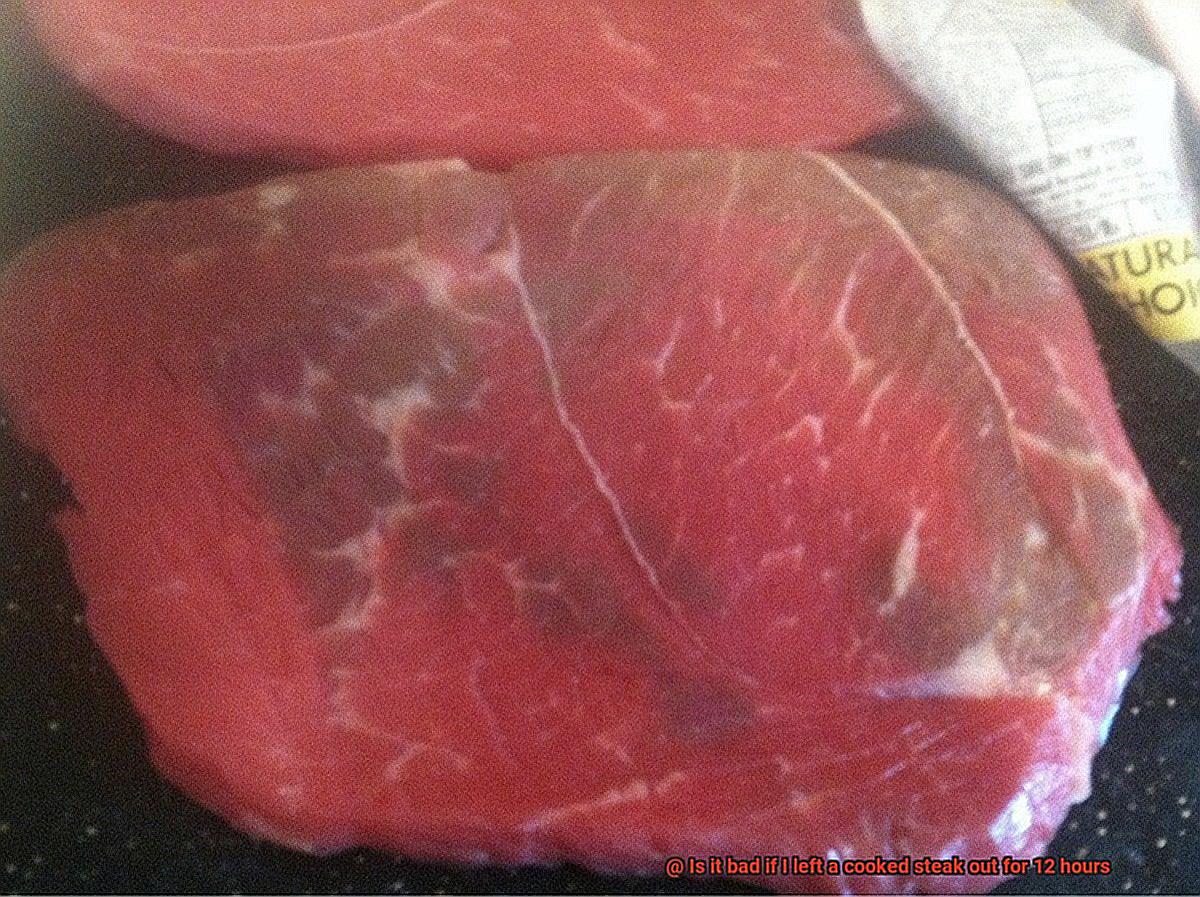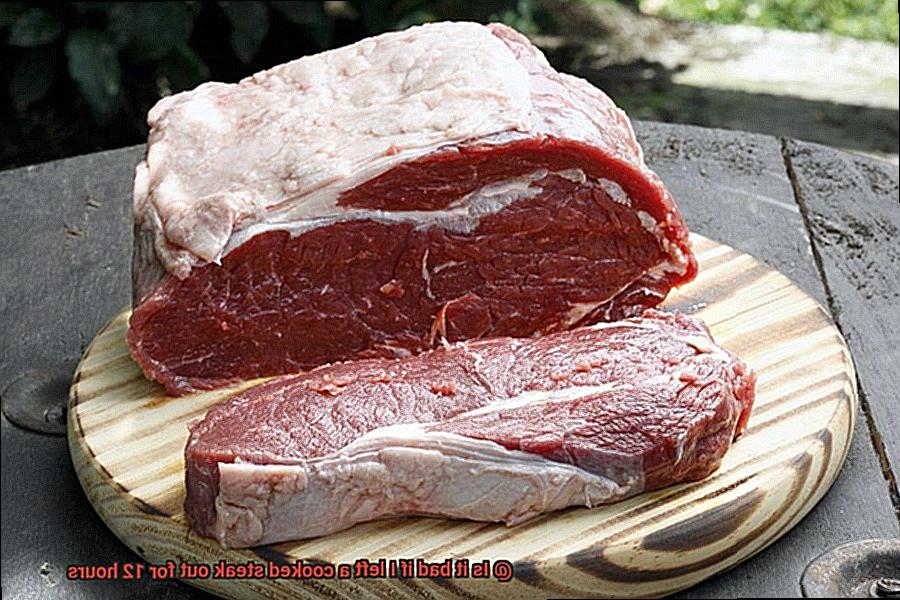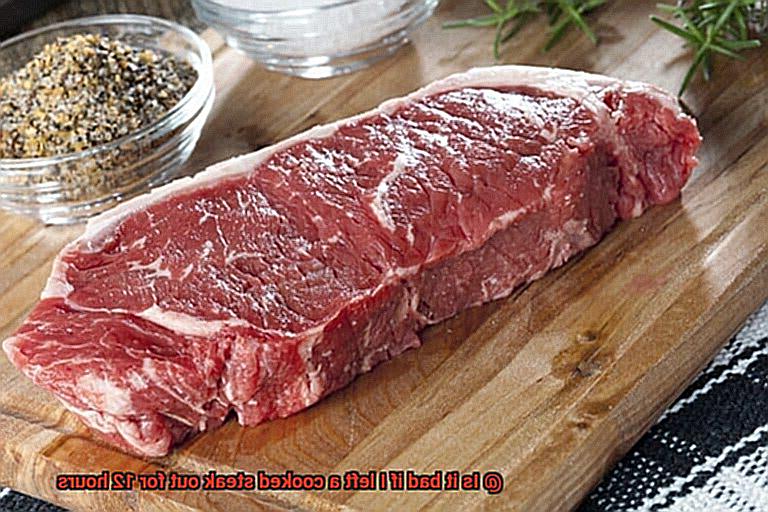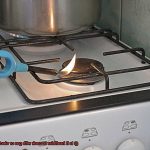Imagine this – you’ve just come home from a tiring day at work and can’t wait to sink your teeth into a mouthwatering steak. You had cooked it to perfection, but then life happened, and you got sidetracked for a bit. Before you knew it, 12 hours had passed, and now you’re left with one question on your mind: “Is it bad if I left a cooked steak out for 12 hours?”
Well, the answer isn’t simple. Leaving cooked food like steak out at room temperature for an extended period can put you in danger of food-borne illnesses. Bacteria thrive between 40°F and 140°F, which means that leaving cooked food out for more than two hours could be risky. And if it’s hot outside, that time limit drops to just one hour.
So what does this mean for your delicious steak? Can you still eat it without worrying about getting sick? In this blog post, we’ll dive deep into the world of food safety and explore the risks and potential consequences of leaving cooked meat out for too long. We’ll also share some helpful tips on how to ensure that your food stays safe from contamination.
Hold onto your hats – we’re about to embark on an adventure through the world of food safety together.
Contents
The Potential Risks of Leaving a Cooked Steak Out
A cooked steak left at room temperature for 12 hours can become a breeding ground for harmful bacteria, including infamous culprits like Salmonella, E. coli, and Staphylococcus aureus. These bacteria are notorious for causing food poisoning and other severe health problems.
The longer a cooked steak sits out, the more time bacteria have to multiply, especially if the steak has not been stored correctly or has been exposed to air. Some bacterial strains can even produce toxins that remain unaffected by cooking, making them all the more dangerous.
Besides bacterial growth, leaving a cooked steak out increases the likelihood of spoilage. Over time, the meat develops an unpleasant odor and taste, coupled with a slimy texture that signifies bacterial growth and renders the steak unsafe for consumption.
Apart from health risks, leaving a cooked steak out for too long can also affect quality. The longer the steak remains at room temperature, the more moisture it loses, resulting in a tough and dry texture when consumed. Furthermore, its flavor may suffer significantly, resulting in an unappetizing meal altogether.
To avoid these risks, following food safety guidelines is vital when preparing and storing food. Cooked meat should always be refrigerated immediately after cooking and never left at room temperature for more than two hours (one hour if the temperature exceeds 90°F). Proper refrigeration will prevent harmful bacteria from multiplying and ensure the safety and quality of your food.
The USDA Recommendations for Cooking and Storing Meat
As much as we love our meat, it’s important to ensure that it’s safe to eat. That’s why the USDA has provided recommendations for cooking and storing meat.
First and foremost, cooking meat to a safe internal temperature is critical. For steak, the USDA recommends cooking it to at least 145°F for medium-rare and 160°F for medium. This ensures that any harmful bacteria are eliminated during the cooking process, reducing the risk of foodborne illness.
Proper storage of cooked meat is just as important. Leaving cooked meat out at room temperature for more than two hours is not advisable because bacteria can grow rapidly between 40°F and 140°F. To keep your steak safe, refrigerate it within two hours of cooking, tightly wrapped in plastic wrap or aluminum foil or stored in an airtight container.
When reheating your steak, make sure to do so thoroughly. The USDA suggests reheating meat to 165°F before consuming, ensuring that any remaining bacteria are eliminated.
To guarantee accurate temperature readings, use a food thermometer. This will help you confirm that your steak has been cooked to a safe internal temperature and that it has been stored and reheated appropriately.
How to Safely Store Cooked Meat
Cooking meat is an art form, but proper storage of cooked meat is a science. Storing cooked meat safely is essential to prevent harmful bacterial growth that can cause food poisoning. Here are five sub-sections on how to safely store cooked meat in the refrigerator and freezer.
Refrigerate Cooked Meat Promptly
The first step in safely storing cooked meat is to refrigerate it promptly. The general rule of thumb is to refrigerate within two hours of cooking. However, if the kitchen temperature is above 90°F, refrigerate within one hour. To avoid air exposure, store the cooked meat in airtight containers or wrap it tightly in plastic wrap or foil.
Keep Cooked Meat Separate
To prevent cross-contamination, always keep cooked meat separate from raw meat. Use separate cutting boards and utensils for raw and cooked meat. Also, store them separately in the refrigerator and freezer.
Store Cooked Meat at Proper Temperature
Storing cooked meat at the correct temperature is crucial to prevent bacterial growth. Keep cooked meat below 40°F in the refrigerator and below 0°F in the freezer. Regularly check your refrigerator and freezer temperature to ensure they are set appropriately.
Use Cooked Meat Within Three to Four Days
Cooked meat can last up to four days in the refrigerator if stored correctly. It’s important to use it within this time frame to avoid any risk of food poisoning. If you don’t plan on using it within that time, consider freezing it.
Freeze Cooked Meat Properly
When freezing cooked meat, wrap it tightly with plastic wrap or aluminum foil before storing it in an airtight container or freezer bag to prevent freezer burn. Properly frozen cooked meat can last up to six months.
What Temperature is the “Danger Zone” for Bacterial Growth?
It’s not a sci-fi movie title, but rather a real temperature range that can put your health at risk. The “danger zone” is between 40°F and 140°F (4°C and 60°C), where bacteria can rapidly multiply and produce toxins that cause food poisoning. Leaving your cooked steak out for 12 hours means you’re playing Russian roulette with your stomach.
But hold on, there’s more. The “danger zone” temperature range may vary depending on the food type. Some foods like cooked rice and potatoes can be at risk of bacterial growth even when stored below 40°F (4°C). Conversely, raw meat, poultry, and seafood must be refrigerated or frozen until they are ready to cook to prevent bacterial growth.
How can you avoid this “danger zone”? It’s simple: store your food properly. Refrigerate cooked food within two hours of cooking or within one hour if the ambient temperature is above 90°F (32°C). When cooking food, use a thermometer to ensure it reaches a safe internal temperature to kill any bacteria present. For example, beef, pork, lamb, and veal steaks should be cooked to a minimum internal temperature of 145°F (63°C) and allowed to rest for three minutes before serving. Ground meats should be cooked to an internal temperature of 160°F (71°C), while poultry should be cooked to an internal temperature of 165°F (74°C).
Types of Bacteria that Can Grow on Cooked Meat Left at Room Temperature
Leaving cooked meat out at room temperature for an extended period is a recipe for disaster. Harmful bacteria can grow and multiply, leading to food poisoning and unpleasant symptoms. In this article, we will explore the types of bacteria that can grow on cooked meat left out at room temperature.
Clostridium perfringens
This bacterium is commonly found in soil and can cause food poisoning when ingested. It thrives in environments with low oxygen levels, such as cooked meat left at room temperature. C. perfringens typically causes symptoms such as diarrhea, abdominal pain, and nausea. It’s essential to note that this bacterium can produce toxins that are not destroyed by reheating the meat, so it’s best to discard any meat left out at room temperature for an extended period.
Staphylococcus aureus
This bacterium is commonly found on human skin and in the nasal passages. It can cause food poisoning when ingested and can multiply rapidly in cooked meat that is left out at room temperature. Symptoms of S. aureus infection include vomiting, diarrhea, and stomach cramps. It’s important to note that even if the meat is reheated properly, the toxins produced by this bacterium may still cause illness.
Bacillus cereus

This bacterium is commonly found in soil and can cause food poisoning when ingested. It thrives in environments with low oxygen levels, such as cooked meat left at room temperature. Symptoms of B. cereus infection include diarrhea and vomiting. It’s crucial to note that this bacterium can produce two different types of toxins – one that causes diarrhea and one that causes vomiting.

Listeria monocytogenes
This bacterium is commonly found in soil and water and can contaminate food during processing or handling. While it’s less common for Listeria to grow on cooked meat left out at room temperature, it’s still a risk. Symptoms of Listeria infection include fever, muscle aches, and gastrointestinal symptoms. Pregnant women and those with weakened immune systems are particularly vulnerable to Listeria infections.

Escherichia coli (E. coli)
This bacterium is commonly found in the intestines of animals and can contaminate meat during processing or handling. While it’s less common for E. coli to grow on cooked meat left out at room temperature, it’s still a risk. Symptoms of E. coli infection include diarrhea, abdominal pain, and vomiting. In severe cases, E. coli infections can lead to kidney failure.
Symptoms of Foodborne Illness Caused by Consuming Contaminated Food
Foodborne illnesses can wreak havoc on our health, causing unpleasant symptoms ranging from mild discomfort to severe complications. As an expert in this field, I want to educate you on the symptoms of foodborne illness caused by consuming contaminated food.
The most common symptoms of foodborne illness include nausea, vomiting, diarrhea, abdominal cramps, and fever. These symptoms can appear anywhere from a few hours to a few days after consuming contaminated food. It’s important to note that the severity of symptoms can vary depending on the type of bacteria or virus that contaminated the food.
Foodborne illnesses can be especially dangerous for vulnerable populations such as young children, elderly individuals, and pregnant women. In severe cases, dehydration, bloody stool, kidney failure, and even death can occur. This highlights the importance of handling and storing food properly to prevent contamination.
Leaving cooked meat out for 12 hours is a grave mistake that can lead to bacterial growth and contamination. This increases the risk of food poisoning and the above-mentioned symptoms. To avoid foodborne illness, it’s crucial to follow proper food safety guidelines such as washing hands before preparing food, cooking meat to the appropriate temperature, refrigerating leftovers promptly, and avoiding cross-contamination between raw and cooked foods.
Who is Most at Risk from Foodborne Illness?
When it comes to foodborne illnesses, no one is immune. However, some groups of people are more vulnerable to these illnesses than others. Young children, pregnant women, older adults, and individuals with weakened immune systems are the most at risk.
Young children have immature immune systems that are still developing. As a result, they may not be able to fight off harmful bacteria as effectively as adults. Therefore, parents and caregivers should take extra care when preparing and serving food to young children.
Pregnant women are also at an increased risk of foodborne illness. Pregnancy can weaken the immune system, making it harder for the body to fight off infections. Additionally, certain bacteria can cross the placenta and harm the developing fetus, leading to severe health problems.
Older adults are another group that is more vulnerable to foodborne illness. As we age, our immune systems weaken, making it harder for our bodies to fight off infections. Moreover, older adults may have underlying health conditions that increase their risk of developing severe illnesses from foodborne pathogens.
Individuals with weakened immune systems, such as those with HIV/AIDS or undergoing chemotherapy, are also at an increased risk of foodborne illness. Their bodies may not be able to combat infections as effectively as healthy individuals, which means they are more likely to develop severe symptoms or complications.
While these groups are at a higher risk of developing severe illnesses from foodborne pathogens, everyone should take precautions when handling and preparing food. Proper food handling and storage techniques can reduce the risk of foodborne illness for all individuals.
y8V7kmj3T9o” >
Conclusion
In summary, leaving a cooked steak out for 12 hours is not only inadvisable but also poses a significant risk to your health. The optimal temperature range for bacterial growth is between 40°F and 140°F, which means that cooked food must be stored at safe temperatures. Failure to do so can result in the rapid multiplication of harmful bacteria like Salmonella, E. coli, and Staphylococcus aureus.
To ensure that your meat is safe to eat, it’s essential to follow the USDA’s guidelines for cooking and storing meat. Refrigerate cooked meat immediately after cooking, wrap it tightly in plastic wrap or aluminum foil, or store it in an airtight container. You should also use a food thermometer to confirm that the meat has been cooked to a safe internal temperature and reheated appropriately.
Proper storage of cooked meat is critical to preventing bacterial growth that can lead to food poisoning. Cooked meat should be refrigerated within two hours of cooking or within one hour if the ambient temperature exceeds 90°F (32°C). It’s crucial to keep cooked meat separate from raw meat, store it at the correct temperature, use it within three to four days, and freeze it properly.
Foodborne illnesses are no laughing matter; they can cause anything from mild discomfort to severe complications. Therefore, handling and storing food correctly is paramount for everyone’s safety. Individuals with weakened immune systems such as young children, pregnant women, and older adults are at higher risk of developing severe illnesses from foodborne pathogens.
In conclusion, always practice proper food safety guidelines when handling and preparing food. Avoid leaving cooked steak out for extended periods as this can lead to unwanted bacterial growth that could compromise your health.






